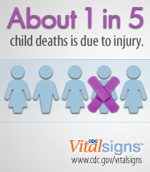A National Action Plan for Child Injury Prevention
Reducing Motor Vehicle-related Injuries in Children
Download Print Version [302KB PDF]

Motor vehicle crashes kill more children in the United States than any other cause of death. In 2009, more than 1,300 children aged 14 years and younger died in motor vehicle crashes and more than 173,000 were injured as motor vehicle passengers.1 Most motor vehicle-related deaths and injuries are predictable and preventable.
A National Action Plan
The Centers for Disease Control and Prevention (CDC) is committed to preventing child injury by supporting solutions that will save lives. The National Action Plan for Child Injury Prevention (NAP) was developed by CDC and more than 60 stakeholders to spark action across the nation. The overall goals of the NAP are to raise awareness about the problem of child injury and the effects on our nation, offer solutions by uniting stakeholders around a common set of goals and strategies, and mobilize action to reduce child injury and death.
The NAP contains six domains that include goals and actions based on what we know, where we need to go, and how we can get there. See below for examples of what we can do to further reduce motor vehicle-related injuries among children.
Data and Surveillance—includes the ongoing and systematic collection, analysis, and interpretation of child health data for planning, implementing, and evaluating injury prevention efforts.
- Enhance usability of Crash Outcome Data Evaluation Systems (CODES) in states that have them, by standardizing the collection of child safety seat use to rear facing, forward facing, or booster seat; and indicating if the child was properly restrained at the time of the crash.2
- Encourage use of standardized and tested forms for child passenger safety seat checks and observational occupant surveys to facilitate data comparison across sites and over time.
Research—includes research gaps and priorities in risk factor identification, interventions, and program evaluation, and dissemination strategies needed to reduce injuries.
- Conduct interdisciplinary research to further determine why parents do not always restrain their children according to child passenger safety (CPS) recommendations.
- Further research the effectiveness of booster seats in reducing nonfatal injuries among children up to age 12 or a height of 4 feet 9 inches.
- Update and expand research related to the child height threshold (4 feet 9 inches) for proper fit of vehicle seat belts for child passengers. The most recent research in this area is almost 20 years old, and significant changes have been made to the vehicle fleet during this time.3 Include exploration of the impact of child obesity on seat belt fit.
Communication—includes effective strategies to promote injury prevention to target audiences, through designing messages and information, and delivering them through relevant channels.
- Collaborate with police and media to personalize child injury news stories and provide incident-related details (such as proper use of child safety seats and details related to the driver).
- Disseminate state-specific CPS messages through multiple channels including “Click-it-or-Ticket” campaigns, day care centers, schools, pediatricians’ offices, and work place settings.
Education and training—includes organized learning experiences for increasing knowledge, attitudes, and behavior change conducive to preventing injuries.
- Encourage child passenger safety certification training among law enforcement, fire, health care, and public health professionals.
- Encourage periodic car seat inspection events at day care centers, preschools, and pediatrician offices.
Health systems and health care—includes the health infrastructure required to deliver quality care and clinical and community preventive services. Health systems can:
- Counsel parents on the stages of CPS and the benefits of CPS seats at well child exams.
- Create “pop-ups” in electronic medical record systems based on child’s age, height, and weight to allow pediatricians to give child-specific CPS messages.
Policy—includes laws, regulations, incentives, administrative actions, and voluntary practices that enable safer environments and decision making.
- Improve state CPS laws to meet height, weight, age, and location specific recommendations and conduct law enforcement led roadside car seat checkpoints.3,4,5
- Require proof of parents having a rear-facing CPS seat prior to newborn hospital discharge, and provide incentives for hospitals to have a nationally certified CPS technician on duty to do car seat checks and CPS education.6
Moving Forward Together
Everyone—including parents, health care providers, educators, and community members—can take steps to prevent injury where they live, work, and play. We all have a part to play in the NAP and in protecting our children—America’s future.
References
- CDC. Web-based Injury Statistics Query and Reporting System [online]. National Center for Injury Prevention and Control, Centers for Disease Control and Prevention (producer). [2010 August 2].
- The Crash Outcome Data Evaluation System (CODES) and Applications to Improve Traffic Safety Decision-Making. Available at: http://www-nrd.nhtsa.dot.gov/Pubs/811181.pdf. Accessed March 27, 2012.
- Durbin DR, Committee on Injury, Violence, and Poison Prevention. Child passenger safety. Pediatrics. 2011 Apr;127(4):e1050-e1066. Epub 2011 Mar 21. Available at: http://pediatrics.aappublications.org/content/127/4/e1050.full.pdf+html. Accessed April 10, 2012.
- National Highway Traffic Safety Administration. Child Safety. Available at: http://www.nhtsa.gov/Safety/CPS. Accessed April 10, 2012.
- Centers for Disease Control and Prevention, National Center for Injury Prevention and Control. Child Passenger Safety: Fact Sheet. Available at: http://www.cdc.gov/MotorVehicleSafety/Child_Passenger_Safety/CPS-Factsheet.html. Accessed April 10, 2012.
- Safe Kids. National Child Passenger Safety Certification. Available at: http://cert.safekids.org/. Accessed April 10, 2012.
Get email updates
To receive email updates about this page, enter your email address:
Contact Us:
- Centers for Disease Control and Prevention
National Center for Injury Prevention and Control (NCIPC)
4770 Buford Hwy, NE
MS F-63
Atlanta, GA 30341-3717 - 800-CDC-INFO
(800-232-4636)
TTY: (888) 232-6348
New Hours of Operation:
8am-8pm ET/
Monday-Friday
Closed Holidays - cdcinfo@cdc.gov





